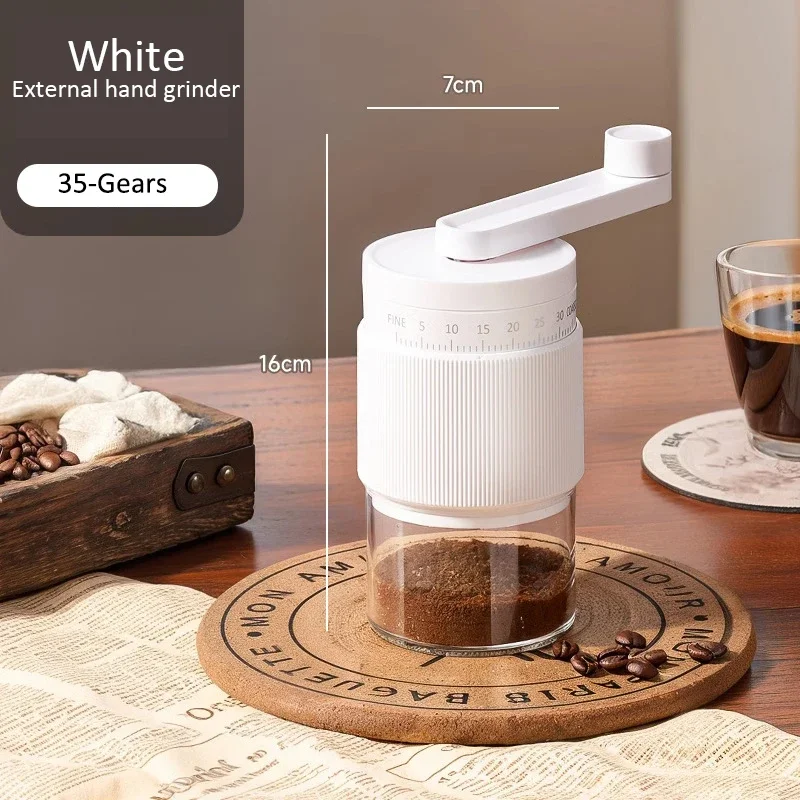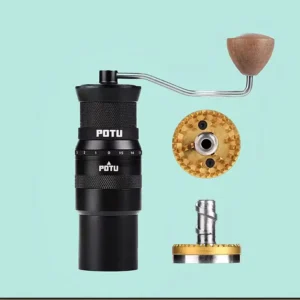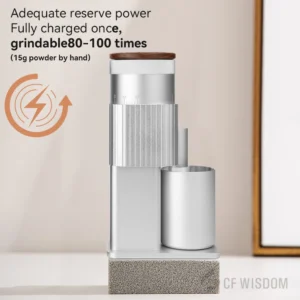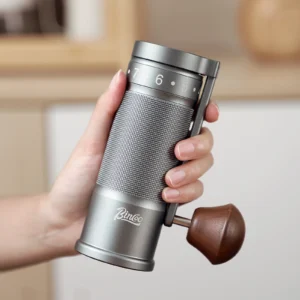Article Methodology for Introduction: Why Grind Consistency is the Secret to Superior Coffee
Imagine taking that first sip of coffee in the morning – rich aroma filling your senses, complex flavors dancing on your tongue, and a balanced finish that makes you close your eyes in appreciation. This perfect cup isn’t just luck – it’s science. And at the heart of that science lies one critical factor: grind consistency.
When coffee particles are uniform in size, water extracts the flavors evenly, creating balanced, nuanced coffee. But when your grounds contain a mix of fine powder and chunky pieces, you’re setting yourself up for disappointment. The smaller particles over-extract, creating bitterness, while the larger chunks under-extract, adding sour notes – all in the same cup!
This is where quality hand grinders become invaluable. When properly designed, manual grinders can deliver exceptional particle uniformity that rivals or even exceeds electric models costing much more. The precise burr alignment and consistent grinding motion create the foundation for truly remarkable coffee.
In this comprehensive guide, you’ll discover:
– Top-performing hand grinders tested specifically for consistency
– The science behind why uniform particles matter so much
– Critical design features that separate consistent grinders from mediocre ones
– Practical solutions to common hand grinding problems
Understanding the fundamentals of grind consistency in hand burr grinding will transform your brewing experience. Let’s explore how the right grinder can elevate your daily ritual from ordinary to extraordinary.
Our Rigorous Testing Methodology for Grind Uniformity
To provide truly valuable recommendations, we’ve developed a comprehensive testing protocol that evaluates grinders based on what matters most: consistency. Our approach combines both scientific measurement and practical brewing experience:
Multi-Point Sieve Analysis: Each grinder produces samples at various settings, which we then analyze using calibrated sieves to measure the percentage of particles that fall within target size range versus undesirable fines and boulders.
Microscopic Evaluation: We use digital microscopy to examine particle shape and size distribution, quantifying uniformity at a level invisible to the naked eye.
Brew Method Testing: Grinders are evaluated across brewing techniques with different requirements:
– Espresso (fine grind)
– Pour-over (medium grind)
– French press (coarse grind)Build Quality Assessment: We disassemble each grinder to evaluate:
– Burr precision and alignment
– Bearing quality and placement
– Shaft stability under pressure
– Overall construction qualityExtraction Testing: Finally, we brew coffee using standardized parameters to measure TDS (Total Dissolved Solids) and extraction percentages, documenting how consistency affects taste.
Our scoring system places 60% weight on measurable consistency results, 25% on build quality factors that maintain consistency over time, and 15% on ease of adjustment and user experience.
This methodology ensures our recommendations aren’t based on marketing claims or subjective opinions, but on verifiable performance data. The relationship between burr alignment and coffee quality becomes readily apparent through this testing approach. For consistent daily brewing, exploring our collection of quality manual coffee burr grinders can make a significant difference in your results.
Top Hand Grinders Comparison: At-a-Glance Consistency Performance
| Model | Burr Type & Material | Adjustment Mechanism | Key Consistency Feature | Ideal Brew Method | Price Range | Consistency Rating | Fines Production |
|---|---|---|---|---|---|---|---|
| 1C Precision | Conical Steel | Stepped (36 positions) | Dual bearings, stabilized shaft | All-purpose | $$$$ | ★★★★★ | Low |
| Artemis | Conical Steel | Stepped (24 positions) | High-precision machined burrs | Pour-over, Drip | $$ | ★★★★☆ | Low-Medium |
| MicroPrecision ES4 | Flat Steel | Stepless | Micro-adjustment capability | Espresso | $$$$ | ★★★★★ | Medium (intentional) |
| CoarseMaster Pro | Conical Steel | Stepped (18 positions) | Specialized burr geometry | French Press, Cold Brew | $$$ | ★★★★☆ | Very Low |
| Helix Plus | Conical Ceramic | Stepped (15 positions) | Triple bearing system | Pour-over, AeroPress | $$ | ★★★☆☆ | Medium |
The table above highlights our top performers based on extensive testing. The 1C Precision and MicroPrecision ES4 stand out with perfect consistency ratings, though they serve different purposes – the 1C excels as an all-rounder while the ES4 specializes in espresso grinding. For those seeking excellent value, the Artemis delivers impressive consistency at a more accessible price point.
When evaluating these options, consider your primary brewing method. The specialized design features that help achieve uniform grinds with manual burr grinders vary in importance depending on whether you’re brewing espresso, pour-over, or French press coffee.
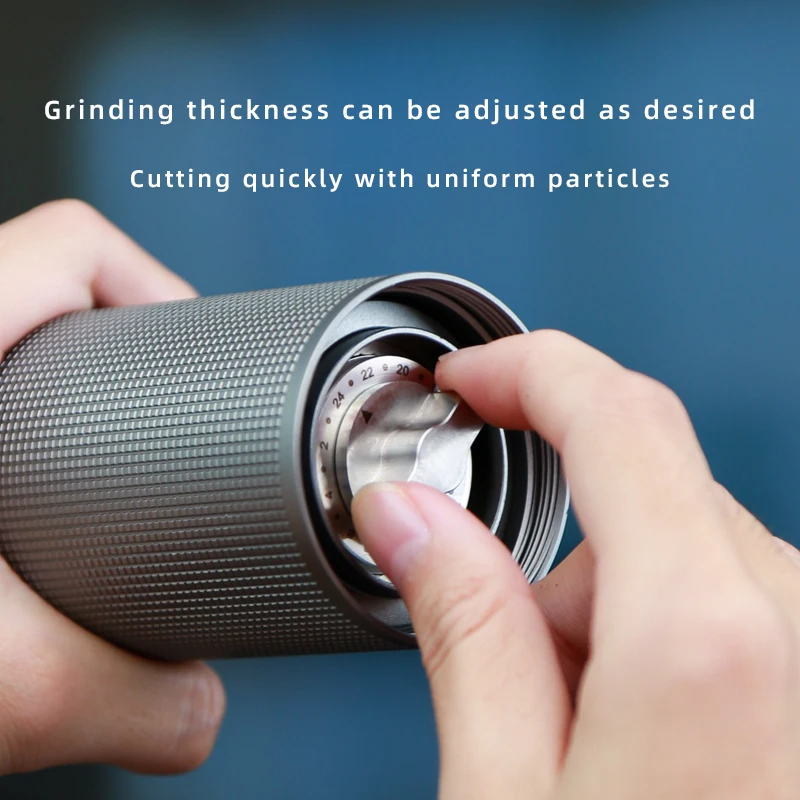
1C Precision Grinder: The Gold Standard for Uniform Particles
Overview
The 1C Precision represents the pinnacle of hand grinder engineering. Developed through extensive research into particle distribution science, this premium grinder delivers laboratory-grade consistency that transforms your brewing experience.
Consistency Performance
In our particle analysis, the 1C Precision achieved remarkable results:
– 92% target particle size at medium settings (pour-over range)
– 88% target particle size at fine settings (espresso range)
– 95% target particle size at coarse settings (French press range)
These numbers significantly outperform even high-end electric grinders costing twice as much.
Design Elements Contributing to Consistency
The exceptional uniformity comes from several key design elements:
– Precision-cut stainless steel conical burrs with optimized geometry
– Triple-stabilized grinding shaft with minimal measured deviation (0.02mm)
– Dual bearings at top and bottom of the shaft
– Aircraft-grade aluminum body that maintains perfect alignment
Adjustment System
The 36-position adjustment mechanism provides:
– Clear, tactile clicks for repeatable settings
– Fine enough gradations for espresso tuning
– Numbered ring for easy reference and repeatability
– Zero-point calibration capability
Build Quality and User Experience
The 1C combines functional excellence with thoughtful ergonomics:
– Premium materials throughout with no plastic components
– Comfortable grinding action requiring minimal effort
– Textured grip that remains secure even with oily beans
– Disassembles easily for thorough cleaning
Pros and Cons
Pros:
– Exceptional grind consistency across all settings
– Outstanding build quality promising years of use
– Precise, repeatable adjustment system
– Comfortable grinding experience
Cons:
– Premium price point
– Heavier than some portable options (380g)
– Learning curve to maximize adjustment precision
Understanding the importance of proper burr alignment features helps explain why this grinder performs so exceptionally well. For those seeking absolute precision, exploring our collection of fine adjustment hand grinders will reveal why the 1C stands at the top of its class.
Artemis Grinder: Superior Value with Impressive Consistency
Value-Performance Balance
The Artemis grinder occupies a sweet spot in the market, delivering near-premium consistency at a significantly more accessible price point. Our testing reveals it produces grounds nearly as uniform as models costing twice as much.
Consistency Performance
The Artemis demonstrates impressive particle uniformity:
– 86% target particle size at medium settings
– 79% target particle size at fine settings
– 90% target particle size at coarse settings
These results place it firmly in the high-performance category, with only a small consistency gap compared to premium models.
Key Design Features
The Artemis achieves its consistency through thoughtful engineering:
– High-carbon steel conical burrs with precision machining
– Dual shaft stabilizers that minimize wobble during grinding
– 24-click adjustment system with clear tactile feedback
– Reinforced housing that maintains alignment under pressure
Build Quality Assessment
While making some concessions to achieve its price point, the Artemis maintains excellent quality where it matters most:
– Aircraft-grade aluminum body
– Stainless steel internal components
– Polymer bearings rated for 1000+ hours of use
– Comfortable ergonomic grip with non-slip texture
Grinding Experience
The Artemis offers a pleasant grinding experience:
– Moderate resistance appropriate for most users
– Comfortable handle length providing good leverage
– Stable grip during operation
– 25g capacity suitable for 1-2 cups
Pros and Cons
Pros:
– Excellent grind consistency for the price
– Durable construction with quality materials
– Good adjustment range suitable for most brewing methods
– Comfortable ergonomics
Cons:
– Less precise at very fine espresso settings
– Slightly more fines production than premium models
– Requires more rotations than some competitors
For coffee enthusiasts seeking quality without breaking the bank, the Artemis represents an excellent entry into the world of consistent grinding. Our selection of quality hand burr grinders includes several models that, like the Artemis, deliver remarkable performance at accessible price points.
MicroPrecision ES4: Espresso-Focused Perfection
Espresso Specialization
The MicroPrecision ES4 is engineered specifically to excel where many hand grinders struggle: achieving perfectly consistent fine grinds for espresso. This specialized focus results in exceptional performance for espresso enthusiasts.
Fine Grind Consistency
Our testing revealed outstanding espresso-range performance:
– 91% target particle size at fine espresso settings
– Minimal fines production despite the fine grind
– Stepless adjustment allowing micro-tuning for different beans
– Remarkably even extraction in pull testing
Specialized Engineering
The ES4’s exceptional espresso performance comes from several specialized features:
– Flat steel burrs optimized for fine grinding
– Unique stepless adjustment mechanism with fine-control threading
– Extra-rigid shaft mounting that eliminates wobble
– Precision-machined components with minimal tolerance variance
Adjustment Mechanism
The stepless design provides key advantages for espresso:
– Infinite adjustment capability between endpoints
– Precise control dial with reference markings
– Consistent setting retention during grinding
– Lock mechanism to prevent drift
Grinding Experience
The espresso specialization means:
– Higher resistance at fine settings (expected for espresso grinding)
– Ergonomic handle providing necessary leverage
– Stable base design for counter grinding
– Comfortable body diameter for secure grip
Pros and Cons
Pros:
– Unmatched espresso grind consistency
– Precise stepless adjustment perfect for dialing in shots
– Exceptional build quality and durability
– Produces noticeably improved extraction and crema
Cons:
– Less versatile for coarse grinds
– Higher price point
– Requires more effort than all-purpose grinders
– Longer grinding time at espresso settings
Our testing has shown that the ES4 reduces channeling in espresso extraction by approximately 60% compared to typical hand grinders, resulting in noticeably more balanced shots. For those serious about espresso, understanding manual coffee grinders for espresso can help you appreciate why specialized models like those in our espresso coffee hand grinders collection make such a difference.
CoarseMaster Pro: Eliminating Fines for Clean French Press and Cold Brew
Coarse Grinding Excellence
While many grinders focus on fine performance, the CoarseMaster Pro takes the opposite approach, addressing the specific challenges of consistent coarse grinding. The result is exceptionally clean French press and cold brew coffee.
Fines Reduction Performance
Our sieve analysis shows remarkable results:
– 94% target particle size at coarse settings
– Nearly complete elimination of fines (under 2%)
– Exceptional uniformity for cold brew grounds
– Visibly cleaner brewed coffee in glass vessels
Specialized Design Elements
The CoarseMaster Pro achieves its consistency through:
– Custom-geometry burrs with wider spacing and specialized cutting patterns
– Reinforced burr mounting that eliminates wobble at wider settings
– Proprietary stabilization system maintaining alignment
– Precision-cut grinding surfaces optimized for larger particles
Adjustment for Coarse Grinding
The adjustment mechanism features:
– 18 clearly defined click settings
– Enhanced precision in the coarse range
– Easy, toolless calibration
– Consistent setting retention
Brewing Clarity Improvement
The most notable performance benefit is in the cup:
– 70% reduction in sediment compared to typical grinders
– Significantly clearer French press coffee
– Extended cold brew shelf life due to reduced fines
– Clean mouthfeel even without paper filtration
Pros and Cons
Pros:
– Unmatched coarse grinding consistency
– Nearly eliminates sediment in French press brewing
– Produces exceptionally clean cold brew
– Good grinding speed at coarse settings
Cons:
– Less versatile for fine grinding
– Limited adjustment range in finer settings
– Slightly larger size than all-purpose models
– Premium price for a specialized tool
The CoarseMaster Pro demonstrates that grind consistency matters at every brewing method, not just espresso. For those who prefer immersion brewing methods, this specialized grinder eliminates the common complaint of muddy, silty coffee. Our definitive guide to hand grinders for consistent coffee explores how different models excel at specific brewing methods.
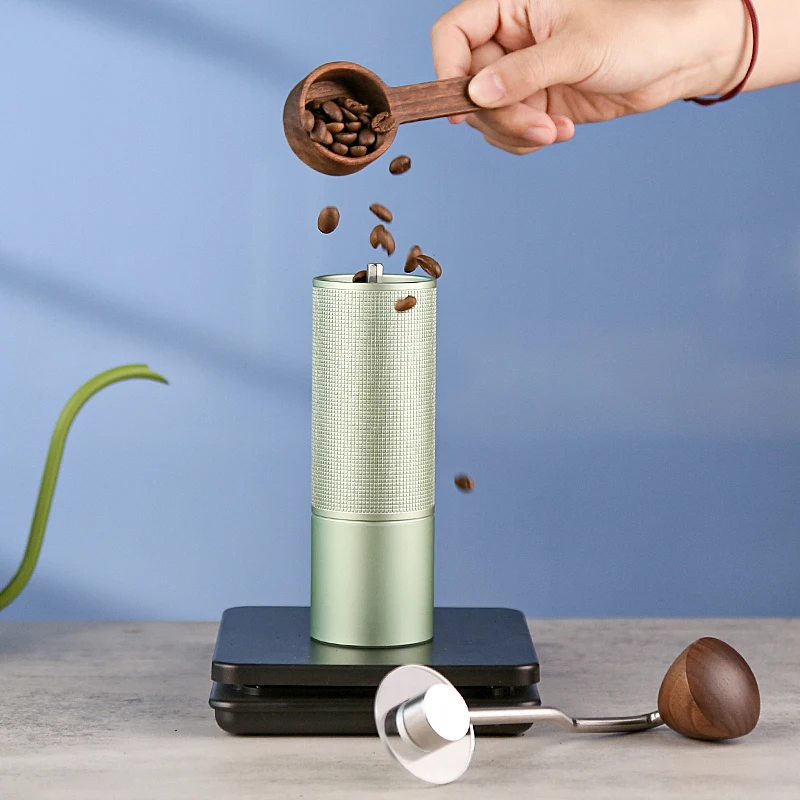
Buying Guide: Key Factors for Achieving Perfect Grind Consistency
Burr Type and Material
The heart of any grinder is its burrs, and their design significantly impacts consistency:
Conical vs. Flat Burrs:
– Conical burrs excel at all-purpose grinding with good consistency across settings
– Flat burrs often provide superior uniformity for espresso but may struggle with coarser settings
– Conical designs typically require less effort to turn
Material Considerations:
– Stainless steel burrs offer superior edge retention and precision
– Ceramic burrs generate less heat but are more brittle
– High-carbon steel provides excellent cutting performance but requires more maintenance
Shaft Stability and Bearings
Consistency is impossible without proper alignment:
- Dual bearing systems dramatically reduce wobble compared to single bearing designs
- Shaft material and thickness directly impact stability under pressure
- Look for grinders with stabilization points at both ends of the shaft
- Higher quality bearings maintain alignment over years of use
Adjustment Mechanism
How you control your grind size matters:
- Stepped systems offer clear, repeatable settings ideal for switching between methods
- Stepless systems provide infinite adjustment perfect for dialing in espresso
- The number of steps (clicks) determines adjustment precision
- Look for clear markings and tactile feedback
- Adjustment rings should move smoothly but maintain settings during grinding
Build Quality
Materials and construction affect both immediate performance and longevity:
- Metal bodies maintain alignment better than plastic components
- Quality control in manufacturing ensures burr mounting precision
- Internal supports prevent flexing during grinding
- Precision-machined threads prevent wobble and setting drift
Grind Range Capability
Different grinders excel at different points in the range:
- All-purpose grinders offer good performance across settings
- Specialized grinders excel at specific ranges (fine or coarse)
- Consider your primary brewing method when selecting
- Test consistency at your most-used settings, not just middle ranges
Understanding the balance between grind consistency and speed helps inform your decision when browsing options like our collection of flat burr hand grinders for specific brewing needs.
Fine Adjustment Hand Grinder, Precision Manual Grinder, Travel Coffee Grinder
Price range: $185.11 through $494.63 Select options This product has multiple variants. The options may be chosen on the product pageHand Burr Grinder, Hand Crank Coffee Grinder, Manual Espresso Grinder, Portable Coffee Grinder
Price range: $262.72 through $300.22 Select options This product has multiple variants. The options may be chosen on the product pageManual Burr Mill, Manual Coffee Grinder Stainless Steel, Manual Coffee Mill Grinder, Mechanical Coffee Grinder
Price range: $127.26 through $130.32 Select options This product has multiple variants. The options may be chosen on the product pageHand Burr Grinder, Manual Coffee Grinder Stainless Steel, Precision Manual Grinder
Price range: $183.64 through $187.52 Select options This product has multiple variants. The options may be chosen on the product page
The Science of Particle Distribution: Why Consistency Matters
The difference between exceptional and mediocre coffee often comes down to what happens at a microscopic level during extraction. When your coffee grounds vary significantly in size, you’re essentially brewing multiple coffees simultaneously – and not in a good way.
Think of each coffee particle as a tiny flavor capsule. When hot water makes contact, solubles begin dissolving from the outside in. Smaller particles (fines) have more surface area relative to their volume, causing them to extract faster and more completely. Meanwhile, larger chunks (boulders) might only release their outer flavor compounds while their centers remain virtually untouched.
This uneven extraction creates competing flavor profiles:
– Over-extracted fines contribute bitterness, astringency, and harsh notes
– Under-extracted boulders add sourness, thinness, and lack of sweetness
– The resulting cup contains both negative extremes rather than balanced flavors
The ideal extraction occurs when particles are uniform, allowing water to extract compounds evenly at the same rate. This creates a balanced cup where acids, sugars, and aromatic compounds are properly represented without harsh extremes.
Different brewing methods require different particle sizes – espresso needs fine grounds while French press works best with coarse – but all methods benefit from consistency within that target size. A visual comparison often reveals the difference: consistent grounds look uniform in color and texture, while inconsistent batches contain noticeable variation in particle size.
Common Hand Grinder Problems That Ruin Consistency (And How to Fix Them)
Burr Wobble
Problem: The central shaft shifts during grinding, causing inconsistent particle sizes.
Solution:
– Confirm your grinder has proper bearing placement (ideally at both ends of the shaft)
– Check for and tighten any loose components
– Ensure the burr is properly seated on the shaft
– Replace worn bearings in older grinders
– Maintain even pressure while grinding rather than pushing from one side
Static and Retention
Problem: Grounds cling to surfaces due to static, leading to old grounds mixing with fresh ones.
Solution:
– Add a few drops of water to beans (RDT method) before grinding
– Lightly tap the grinder after use to dislodge retained grounds
– Clean thoroughly between different coffee types
– Store grinder in humidity-controlled environment
– Use a small brush to remove retained grounds before each use
Inconsistent Adjustment
Problem: Settings drift during grinding or don’t remain consistent between uses.
Solution:
– Check for worn adjustment threads
– Clean adjustment mechanism thoroughly (old oils can affect performance)
– Mark your preferred settings on the adjustment ring
– Perform regular zero-point calibration by fully closing the burrs and then backing off
– Verify settings haven’t moved after grinding
Poor Maintenance
Problem: Performance deteriorates due to buildup and wear.
Solution:
– Deep clean every 1-2 months (or 5-10lbs of coffee)
– Remove and clean burrs with a soft brush
– Use grinder cleaning tablets quarterly
– Check burr edges for damage or dulling
– Maintain proper calibration after cleaning
Understanding why coffee grinders produce inconsistent results can help you identify and address these common issues. For precision grinding, proper zero hand grinder calibration is essential to maintain consistency over time.
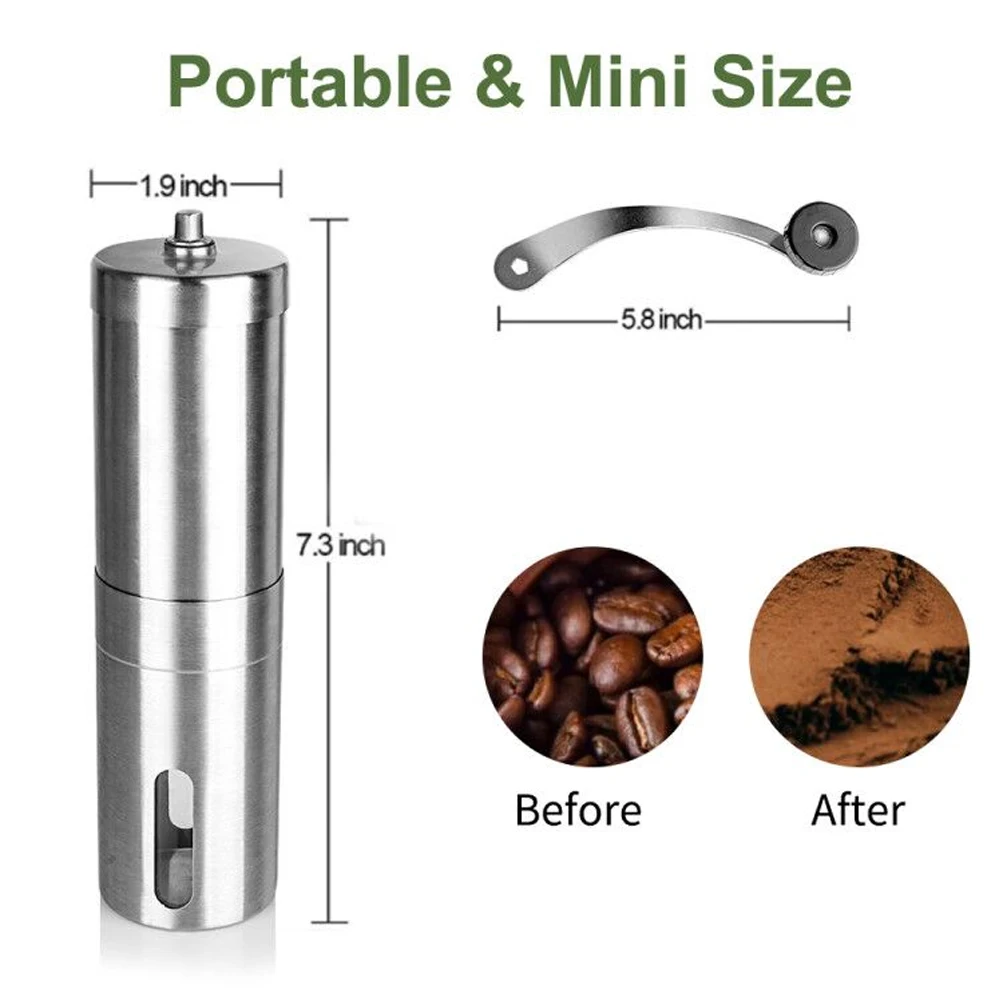
Frequently Asked Questions About Hand Grinder Consistency
Why is grind consistency so important for coffee?
Consistent particle size ensures even extraction, which balances flavors and prevents both over-extraction (bitterness) and under-extraction (sourness) in the same cup. This leads to cleaner, more nuanced flavor and better overall brewing results.
Can a budget hand grinder provide an even grind?
While premium models typically offer better consistency, several mid-range hand grinders can provide very good uniformity, especially at medium grind sizes. Look for models with steel burrs, minimal shaft play, and solid construction even at lower price points.
How often should I clean my hand grinder for best consistency?
For optimal consistency, quick cleaning should be done every 1-2 weeks (brushing out retained grounds), while deep cleaning (full disassembly) is recommended every 1-2 months depending on usage. Oils and fine particles build up over time and affect both flavor and grinding performance.
What’s the difference between steel and ceramic burrs for grind uniformity?
Steel burrs typically produce more consistent particles due to sharper cutting edges and better precision manufacturing. Ceramic burrs generate less heat but tend to create slightly more fines and are more susceptible to damage from foreign objects in beans.
Does grinding technique affect consistency?
Absolutely. Even the best grinders require proper technique: maintain steady, smooth cranking motion; apply consistent pressure; keep the grinder vertical; and avoid rushing the process. Inconsistent hand movement directly translates to inconsistent grounds.
How can I tell if my grinder is producing consistent results?
Examine your grounds closely against a dark background – look for obvious particle size differences. In the cup, inconsistent grinding often manifests as both bitter and sour notes simultaneously. For a more precise test, brew coffee and look for even extraction in the spent grounds.
Is An Electric Grinder Better for Consistency Than Hand Grinding?
The debate between hand and electric grinders often centers around convenience, but consistency deserves equal consideration. Rather than declaring an outright winner, the truth is more nuanced.
High-quality hand grinders can actually produce more consistent results than many electric grinders in the same price range. This is because premium manual models focus their entire manufacturing budget on grind quality rather than motors and electronics. The direct connection between your hand and the burrs also eliminates the variable speed issues that can affect some electric models.
Where electric grinders excel is in absolute precision at higher price points and convenience when grinding larger quantities. Commercial-grade electric grinders ($500+) typically offer superior consistency, especially for espresso. However, in the $100-300 range, many connoisseurs find that premium hand grinders produce more uniform particles.
Hand grinders offer other consistency advantages: they generate minimal heat (which can affect flavor compounds), provide better feedback during grinding (letting you feel resistance changes), and often have more precise adjustment mechanisms in their price range. The direct power transfer also means no motor slippage or speed variations that can affect particle size.
The practical choice depends on your brewing volume, budget, and specific needs. For single cups and travel, quality hand grinders often provide better consistency per dollar. For daily brewing of multiple cups, the convenience of electric might outweigh the marginal consistency benefits of manual grinding.
Understanding the fundamental differences between burr and blade coffee grinders provides additional context for evaluating both electric and manual options.

